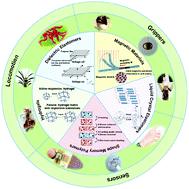当前位置:
X-MOL 学术
›
J. Mater. Chem. B
›
论文详情
Our official English website, www.x-mol.net, welcomes your
feedback! (Note: you will need to create a separate account there.)
Stimuli-responsive functional materials for soft robotics.
Journal of Materials Chemistry B ( IF 6.1 ) Pub Date : 2020-08-18 , DOI: 10.1039/d0tb01585g Zequn Shen 1 , Feifei Chen 1 , Xiangyang Zhu 1 , Ken-Tye Yong 2 , Guoying Gu 1
Journal of Materials Chemistry B ( IF 6.1 ) Pub Date : 2020-08-18 , DOI: 10.1039/d0tb01585g Zequn Shen 1 , Feifei Chen 1 , Xiangyang Zhu 1 , Ken-Tye Yong 2 , Guoying Gu 1
Affiliation

|
Functional materials have spurred the advancement of soft robotics with the potential to perform safe interactions and adaptative functions in unstructured environments. The responses of functional materials under external stimuli lend themselves to programmable actuation and sensing, opening up new possibilities of robot design with built-in mechanical intelligence and unlocking new applications. Here, we review the development of stimuli-responsive functional materials particularly used for soft robotic systems. This review covers five representative types of soft stimuli-responsive functional materials, namely (i) dielectric elastomers, (ii) hydrogels, (iii) shape memory polymers, (iv) liquid crystal elastomers, and (v) magnetic materials, with focuses on their inherent material properties, working mechanisms, and design strategies for actuation and sensing. We also highlight the state-of-the-art applications of soft stimuli-responsive functional materials in locomotion robots, grippers and sensors. Finally, we summarize the current challenges and map out future trends for engineering next-generation functional materials for soft robotics.
中文翻译:

用于软机器人的刺激响应功能材料。
功能材料促进了软机器人技术的进步,具有在非结构化环境中执行安全交互和自适应功能的潜力。功能材料在外部刺激下的响应有助于可编程驱动和传感,为具有内置机械智能的机器人设计开辟了新的可能性,并解锁了新的应用。在这里,我们回顾了特别用于软机器人系统的刺激响应功能材料的开发。本综述涵盖了五种具有代表性的软刺激响应功能材料,即(i)介电弹性体、(ii)水凝胶、(iii)形状记忆聚合物、(iv)液晶弹性体和(v)磁性材料,重点关注它们固有的材料特性、工作机制以及驱动和传感的设计策略。我们还重点介绍了软刺激响应功能材料在运动机器人、夹具和传感器中的最先进应用。最后,我们总结了当前的挑战,并规划了软机器人工程下一代功能材料的未来趋势。
更新日期:2020-10-14
中文翻译:

用于软机器人的刺激响应功能材料。
功能材料促进了软机器人技术的进步,具有在非结构化环境中执行安全交互和自适应功能的潜力。功能材料在外部刺激下的响应有助于可编程驱动和传感,为具有内置机械智能的机器人设计开辟了新的可能性,并解锁了新的应用。在这里,我们回顾了特别用于软机器人系统的刺激响应功能材料的开发。本综述涵盖了五种具有代表性的软刺激响应功能材料,即(i)介电弹性体、(ii)水凝胶、(iii)形状记忆聚合物、(iv)液晶弹性体和(v)磁性材料,重点关注它们固有的材料特性、工作机制以及驱动和传感的设计策略。我们还重点介绍了软刺激响应功能材料在运动机器人、夹具和传感器中的最先进应用。最后,我们总结了当前的挑战,并规划了软机器人工程下一代功能材料的未来趋势。











































 京公网安备 11010802027423号
京公网安备 11010802027423号